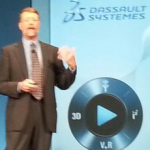Nov19
Innovating by Fusing Reality and Virtual Reality: Joe Pine #3DXForum
Point: Looking at the opposites of everyday constraints yields new opportunities for innovation.
Story: Companies typically see time, space and matter as constraints. That’s not surprising — those three elements define the boundaries of our everyday reality. But what if we saw them not as constraints but as malleable resources for innovation?
That’s the mind-bending proposition Joe Pine presented at Dassault Systèmes’ 3DEXPERIENCE Forum. Lest you dismiss Pine as a wide-eyed dreamer, recall that his book, Mass Customization, introduced a seemingly impossible paradox when it was released in 1992, but that concept is now so widely implemented that it’s a de rigueur business practice. The fusion of opposites provides opportunities for innovation.
So how do we utilize time, space and matter for innovation? Pine lays out the steps in his latest book, Infinite Possibility. The way forward, Pine says, is to play with the opposites of time, space and matter, namely no-time, no-space and no-matter. Whereas time, space and matter constitute our usual realm of Reality, no-time, no-space and no-matter constitute a new realm of pure Virtual Reality
If we fuse reality and virtual reality in various mix-and-match combinations, then we can come up with a host of new products, services and, most importantly, customer experiences. Using these three dimensions, Pine details an eight-realm new universe (“multiverse”) that pairs eight combinations of time vs. no-time, space vs. no-space, matter vs. no-matter.
Let’s start by exploring a realm that is only one step removed from reality, what Pine calls “Augmented Reality.” Compared to reality, which has time, space and matter, Augmented Reality has time, space and no-matter. The “no-matter” condition refers to the information that is overlaid onto reality.
Here’s an example: say you’re driving down the street in a city unfamiliar to you. You are in a real space and in a real time. But, you can use a device to overlay information (“no-matter”) onto that current reality. That is, you can use a GPS navigation aid to show you where the nearest bakery is. The GPS gives you data (“no-matter”) that you can’t see yet in the real world (a bakery around the corner a few blocks away). With that information, your reality is augmented — you can navigate to the bakery and get the cupcake you crave.
Companies can apply these concepts to new product development. For example, what new products or enhanced experiences could you create in Augmented Reality? Dassault Systemes’ CEO Bernard Charles demonstrated one such product, 3DParis. With this app, you can stroll the streets of Paris and see an overlay of your current street in olden times — 2000 years of Parisian history showing you how the street you’re walking down looked, say during the time of the French Revolution in 1789.
That’s a playful consumer app; the same principles apply to hardcore business operations, such as airplane repair. Consider an app that lets mechanics point an iPhone at a distant airplane on the tarmac and get an immediate overlay of the maintenance and repairs that need to be done for that specific plane.
Action
- Look for ways to virtualize your product, service, or business along one or more of the three dimensions of time, space and matter. Break the constraints on the “when,” “where,” and “what.”
- Consider ways to replace or enhance the matter of a product, service, or business with data, graphics, and manipulated versions of reality
1 Comment »Growth, Innovation, New Product Development, Opportunity, Social Media, Software tool












